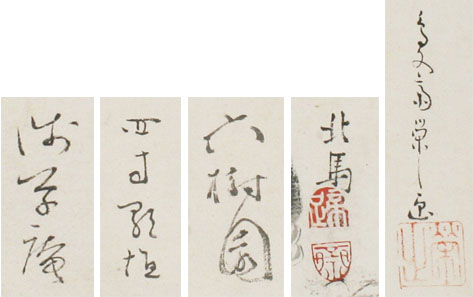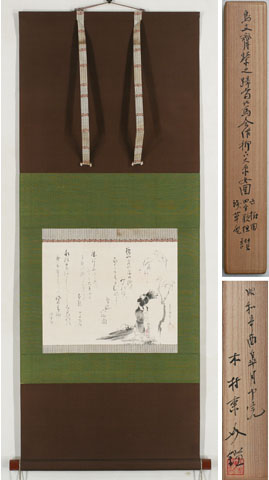Ukiyo-e (Surimono)
Oharame and Yanagi - Willows and girls from OharaSigned: *
Seals: Eishi & Teisai
Technique: sumi on paper 24.9 x 32.7
Date: before 1820
Mounting: Green silk and brown satin Tokugawa style 111 x 43.6
Box: Authorized in 1981 by Kimura Tôsuke (1901-1992) (a well-known dealer and expert on ukiyo-e paintings)
Condition: Fine
The poems kyôka read:
Long twigs of the willow,
at the approach to the bridge -
like tangled hair:
rain comes to caress them
and wind to bend them backward. Rokujûen
(This refers to the story of the King of the State of Chu and the goddess of Mount Wu who appeared to him in a dream after which they spent the night together. In the daytime she manifests herself as clouds [wind] and in the night as rain).
Sweeping away the rubbish,
the swallow with its behind up
is it a girl from Ohara?
Trembling as learned from the wind
running through the willow... Yomo no Utagaki
(Gathering firewood, the girls from Ohara constantly bend over. When the swallows gather twigs for their nest they bend over and show their bottoms. Dirty minds make the association with the story of first Japanese couple Izanagi and Izanami who were inspired by the wagtail how to make children and populate the islands.)
The whole day long
washing itself in the water
it is still not dried
as it has become used to the wind,
the willow with its green leaves. Sensoan
(The girls from Ohara can’t get enough of “doing it”, and have no idea when to stop). (HK)
The Hosoda family in which Eishi was born had high positions as retainers of the Shôgun. They claimed to be offspring of the important Fujiwara clan.
At the age of 15 after his father’s dead he became head of the family. Due to his classical education and his interest in painting he became a student with the court painter Kanô Eisen-in Michinobu (1730-1790). In 1781 Eishi was appointed Konanduyaku, chamberlain in charge of the shôguns collection of paintings, but already resigned after 2 years and to become Yoriai, special attendant to shôgun after another year. In 1789 he resigned handed over the position as head of the Hosoda clan over to his adopted son Tokitoyo (1772-1828). From then on he successfully produced prints. In 1800, after the empress had gracefully received one of his paintings he decided to concentrate on paintings only.
He became one of the finest Ukiyo-e painters who remained true to his original Kanô style.
Reference:
Brandt 1977
Roberts p. 22
Araki p. 2331
Clark p. 122
Rosenfield B. 19 (# 221-223)
Hokuba was born and lived in Edo. With Hokkei (1780-1850) and Shinsai (act. 1799-1823) he was one of the early outstanding pupils of Katsushika Hokusai (1760-1849). With Okaki Ichindo (Sensôan)(1755-1820) he studied Kyôka poetry. As a print artist he designed illustrated (especially Kyôka) books and a small number of surimono.
Hokuba was one of the few pupils of Hokusai that established a style of his own. He worked originally in the Kanô style, which changed under the influence of Hokusai.
Hokuba was a successful painter of bijinga and sceneries of famous places. It seems that he frequently traveled to the provinces where he painted commissions for country patrons.
Reference:
Clark ‘93 p. 164 (# 114-125)
Fitski pp. 53-56 (# 28-29)
Utagaki, Rokujuen and Sensôan were the leaders of different important Edo kyôka poetry groups.
Price: ON REQUEST

